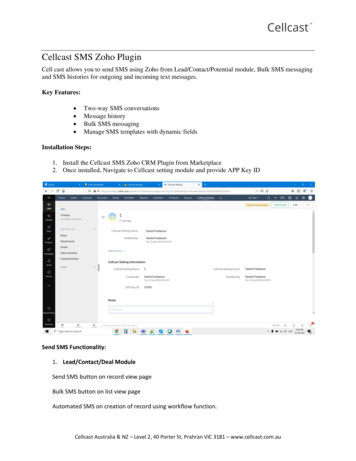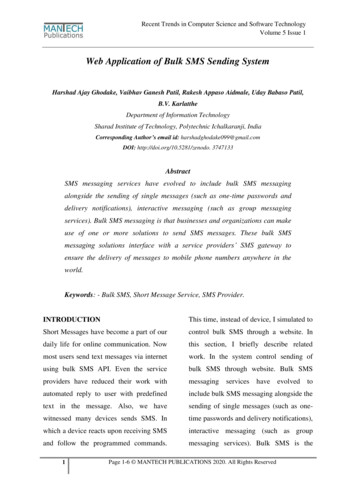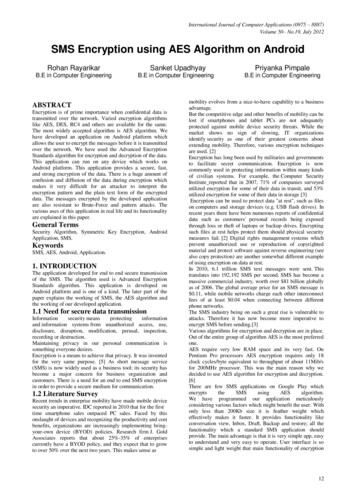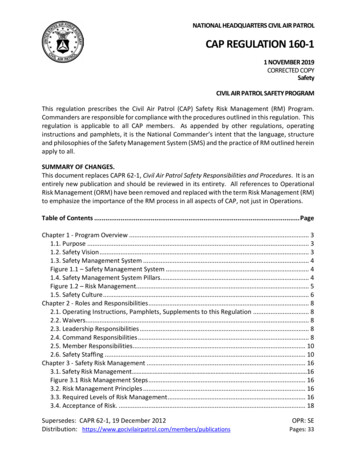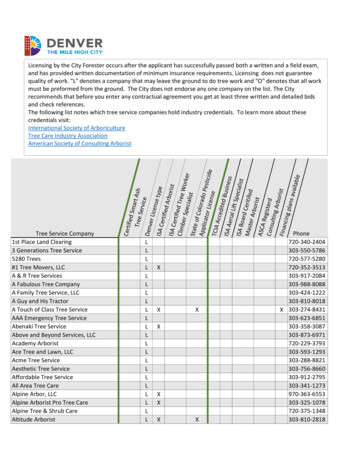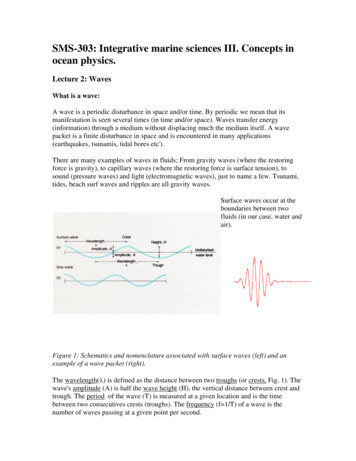
Transcription
SMS-303: Integrative marine sciences III. Concepts inocean physics.Lecture 2: WavesWhat is a wave:A wave is a periodic disturbance in space and/or time. By periodic we mean that itsmanifestation is seen several times (in time and/or space). Waves transfer energy(information) through a medium without displacing much the medium itself. A wavepacket is a finite disturbance in space and is encountered in many applications(earthquakes, tsunamis, tidal bores etc').There are many examples of waves in fluids; From gravity waves (where the restoringforce is gravity), to capillary waves (where the restoring force is surface tension), tosound (pressure waves) and light (electromagnetic waves), just to name a few. Tsunami,tides, beach surf waves and ripples are all gravity waves.Surface waves occur at theboundaries between twofluids (in our case, water andair).Figure 1: Schematics and nomenclature associated with surface waves (left) and anexample of a wave packet (right).The wavelength(λ) is defined as the distance between two troughs (or crests, Fig. 1). Thewave's amplitude (A) is half the wave height (H), the vertical distance between crest andtrough. The period of the wave (T) is measured at a given location and is the timebetween two consecutives crests (troughs). The frequency (f 1/T) of a wave is thenumber of waves passing at a given point per second.
To first order, surface waves do not, in average, move water. Rather, it is the wave formthat is propagating (thus energy/information is propagating). Each point on the surfacetraces a circle (Fig. 2).Figure 2: right panel: wave structure, left panel: trajectories of particles at differentdepth and different positions relative to a wave. (Figure 9.2-9.3 in Garrison, 2001)The phase speed of waves is the speed by which a trough (crest) propagates (c λ/T). Thespeed of a group of waves is called the group-speed (cg) of the wave and is the speed bywhich energy (or information) propagates. The two are not necessarily the same and caneven propagate in different directions (as is the case for internal wave in continuouslystratified fluids). For example, in a boat's wake one can observe how crests rise from therear end of the edge formed behind the boat and disappear in its front edge, moving faster(in fact twice as fast) as the propagation of the wedge itself (the 'group').The position of the surface of a wave traveling in the x direction is approximated as asinusoidal: η Asin{2π(x/λ-t/T)}. The expression in bracket is the phase of the wave andgoes from 0 to 2π from crest to crest. It is a mathematical fact that any surface can bedecomposed uniquely into a sum of sines and cosines of different wavelengths (orfrequencies, this is a result of the work of Fourier).The period of a wave may look shorter or longer to us depending on whether the wave isriding on top of a mean current. This phenomena is known as the Doppler shift. If thecurrent propagates in the same direction as the wave, the period an observer standing atpoint facing the current will measure will be shorter (more wave will come by him perunit time) while when the waves propagate opposite the current directions the periodmeasured by a static observer will be longer. Moving with the current, the wave will havethe same period as in the absence of current.Deep and shallow water waves:
Surface gravity waves are divided into two groups depending on whether they do or donot feel the presence of the bottom (Fig. 3).Figure 3: Changes in a wave as the depth shallows. Note change in particle trajectories,wavelength and steepness (H/λ). (Figure 9.11 in Duxbury, Duxbury and Sverdrup, 2000)For gravity waves it can be shown that the phase speed is:c λ/T [gλ/2π·tanh(2πh/λ)]1/2 where h is the depth of the fluid.When λ 2h (deep water waves), tanh(2πh/λ) 1, and c [gλ/2π]1/2When λ 20h (shallow water waves), tanh(2πh/λ) 2πh/λ, and c [gh]1/2While deep water waves of different length travel at different speeds (the long ones fasterthan the short ones), all shallow water waves travel at the same speed.Group speeds (the speed of energy propagation) are equal to phase speed for shallowwater waves and are half the phase speed of deep water waves.The amplitude of surface gravity waves decays exponentially with depth (z), (exp(-kz))with a decay constant being the wavenumber (k), k 2π/λ.Tsunamis are waves generated by seismic activity (earthquakes). A tsunami has a typicalwavelength λ 200km. Thus, even in deep ocean (h 5km) they behave like shallow waterwaves. The amplitude of Tsunamis in the middle of the ocean is O(1m) and thus are notdistinguishable from the waves around them. Their speed is similar to sound speed in air, 300m/s.
Generation of Surface waves:The primary generation process of surface waves is the wind (Figure 1.3 below).Differential stresses and pressure along the interface pushes the waves and steepens them.(Figure 1.3 from Waves, Tides and Shallow-water processes, The Open University)Another source of surface waves are earthquake around the world. The devastating wavethey produce is called a Tsunami (see above).The surface of the ocean is made of a superposition (namely the sum) of many waves.Waves travel in different directions and their amplitude add up (Fig. 4)
Figure 4. Superposition of waves (Figure 9-9 in Thurman, 1997).Most of the energy in waves is due to wind waves with periods from 1 to 10 seconds(Fig. 5). Waves have both kinetic and potential energy. The total energy per unit area of awave is given by:E (ρgH2)/8.Where ρ is density, g-gravitational acceleration, and H, the wave's height.
Figure 5. Distribution of energy as function of wave period and type. (Figure 9.4 inGarrison, 2001)Breaking waves:As deep water waves get to shallow areas their speed decrease and their amplitudesincrease accordingly (to conserve mass). Once the wave achieve critical steepness(Η/λ 1/7) they break (Fig. 6). The energy the wave had is mostly dissipated into heat.Some of the energy may be channeled into creating strong 'rip' currents.Figure 6: Waves approaching the shallow areas steepen and than break.Seich:Just as with musical instruments such as drums, lakes and embayment have their ownnatural frequency for surface gravity waves that depend on their depth .and theirhorizontal dimensions. When excited at the appropriate frequency large oscillations areproduced having that frequency.Hull speed:An object moving along on the fluid surface (boat, duck), generates a surface wave withtwo crests at both ends of the object and the trough in between. The length isapproximately equal to the water-line length of the hull (L). The natural phase speed ofthis wave is c (gL/(2π))1/2, and is called the hull speed. If the objects tries to swim fasterthan its hull speed it will need to move uphill over the wave it is forming, creating extraresistance in the process. The energetic cost of moving faster than the hull speed is suchthat ducks do not attempt it and so do not boats. Thus the length of a boat (swimmer) isvery important in determining the maximal speed that can be sustained for a while.Internal waves:
In oceans and lakes not only surface waves exist but possibly also internal waves. Thesimplest to understand are those that travel along the interface between dense deep fluidand the overlaying light fluid as this is similar to waves on the surface of the water (butbelow the light atmosphere). In continuously stratified fluid internal wave can propagatevertically. What is counter intuitive is that their phase and group velocities areperpedicular. These wave transmit energy from surface to depth and back and arebeleived to play an important role in ocean mixing as they break over steap topography.Beautiful movies of such waves can be found at:http://www.gfd-dennou.org/library/gfd exp/exp e/index.htm.References and additional reading:Denny, M. W., 1993, Air and Water, Princeton U. Press, Ch. 13.Duxbury, A. C., A. B. Duxbury, and K. A. Sverdrup, 2000. An introduction to theWorld's Oceans, Mc Graw Hill, Ch. 9.Garrison, T., 2001. Essentials of Oceanography. Brooks/Cole. Ch. 9.Pinet, R. 2000. Invitation ot Oceanogrpahy. Jones and Bartlett. Ch. 7.Pond, S. and G. L. Pickard, 1983. Introductory Dynamical Oceanography, PergamonPress, Ch. 12.Thurman, H. V., 1997. Introductory Oceanography. Prentice Hall. Ch. 9.Waves, tides and shallow-water processes, The open university, Pergamon press. Boss, 2007This page was last edited on 10/4/07
depth and different positions relative to a wave. (Figure 9.2-9.3 in Garrison, 2001) The phase speed of waves is the speed by which a trough (crest) propagates (c λ/T). The speed of a group of waves is called the group-speed (cg) of the wave and is the speed by which energy (or information) propagates. The two are not necessarily the same and can
